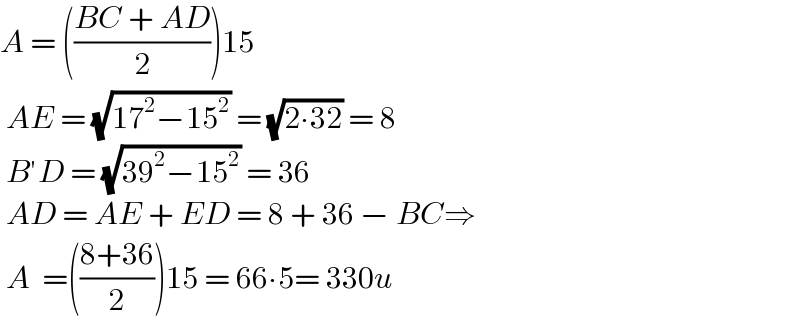
Question and Answers Forum
Question Number 183886 by Acem last updated on 31/Dec/22

Answered by HeferH last updated on 31/Dec/22

Commented by Acem last updated on 31/Dec/22

Answered by mr W last updated on 31/Dec/22

Commented by mr W last updated on 31/Dec/22
![[ABCD]=[ΔABF]=((AF×BG)/2) =((((√(17^2 −15^2 ))+(√(39^2 −15^2 )))×15)/2) =((44×15)/2)=330 ✓](Q183896.png)
Commented by manxsol last updated on 31/Dec/22
![the formula would then be Areatrap(d1,d2,h)= [(√(d1^2 −h^2 )) +(√(d2^2 −h^2 ]))×(h/2)](Q183905.png)
Commented by manxsol last updated on 31/Dec/22

Commented by Acem last updated on 31/Dec/22

Answered by mr W last updated on 31/Dec/22
![alternative: cos α=((15)/(17)) ⇒sin α=((√(17^2 −15^2 ))/(17))=(8/(17)) cos β=((15)/(39)) ⇒sin α=((√(39^2 −15^2 ))/(39))=((36)/(39)) [ABCD]=(1/2)×17×39×sin (α+β) =(1/2)×17×39×((8/(17))×((15)/(39))+((15)/(17))×((36)/(39))) =((15×44)/2)=330 ✓](Q183897.png)
Commented by Acem last updated on 31/Dec/22

Commented by mr W last updated on 31/Dec/22

Commented by mr W last updated on 31/Dec/22

Commented by Acem last updated on 31/Dec/22

Answered by Acem last updated on 31/Dec/22

